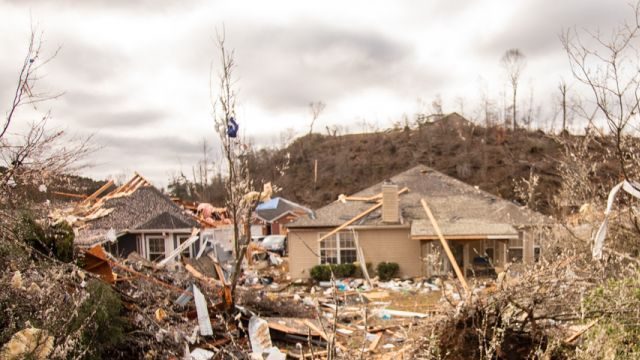By Donna Cope
Alabama Newscenter
Working in what could be compared to a war zone, a team of UAB doctors and nurses performed an onsite amputation to save an injured man after the F3 tornado hit Fultondale Jan. 25.
Sometime after midnight, UAB trauma surgeon Dr. Don Reiff received a call from Vestavia firefighter and paramedic Lawrence Pugliese. The firefighter was in Fultondale, where Arnoldo Vasquez Hernandez was trapped under a tree inside his home. Pugliese likened the scene to an explosion: tree after tree, house after house, all kinds of debris were everywhere.
“Pugliese reached out to get some insight about what to do with a tourniquet if they were able to extricate the patient from the scene,” said Reiff, who, as part of a volunteer medical team from UAB, works with Pugliese and the Vestavia SWAT team. “He called back later and indicated they weren’t going to be able to get the patient out, … that he was trapped.” An infield amputation would be needed.
Reiff contacted one of his partners at UAB Hospital to prepare surgical instruments. Fultondale paramedics also called UAB Emergency Room Dr. Blayke Gibson for help. Gibson contacted UAB Trauma Director Dr. Jeffrey Kerby, who helped her and Reiff determine a game plan for treating the patient onsite.
“The team in the Emergency Department was incredible … they had all of our supplies ready and we were ready to leave the ED in 20 minutes,” said Gibson, who did her medical residency training at UAB. “Every person in that ED that night, all of the nurses, the techs, the remaining physicians who control the Emergency Department so that some of us could go to the scene, were incredible.”
Pugliese warned that time was of the essence: “The house was actively collapsing inside. That was not good,” he said. Reiff immediately drove to Fultondale, where Fultondale and Birmingham fire departments were already working to fortify the scene.
A huge oak tree was on top of and inside the house. Paramedics from Fultondale and Mt. Olive, unable to move Hernandez or the tree, could only set an IV.
When India Alford, director of UAB’s freestanding ED in Gardendale, learned tornadoes were coming through, she went into work. Alford and UAB ED Trauma/Burns Nurse Manager Sherichia Hardy were called by UAB to help the patient in Fultondale. An ambulance took them to the site, where they assessed the trauma victim, then set an intravenous line to resuscitate him with fluids and blood to prepare him for surgery.
“When I heard for sure that Dr. Reiff and Dr. Gibson were coming, my heart was just glad because the firefighters had come to us and said that they were going to allow the patient to call his family,” Hardy said. “At that moment, prior to our surgeon and physician being able to come out, it was really looking pretty grim to be able to get him out safely.”
Hardy and Alford had everything ready for the doctors. UAB Police transported Gibson and the surgical equipment to the scene. Gibson managed the patient’s airway and made sure he was appropriately sedated and as pain-free as possible.
“From there, Blayke took care of everything that would have been the head of the bed if we’d been in the hospital doing this, so that I could focus on performing the amputation,” Reiff said. “We secured two good tourniquets, and then I performed an above-knee guillotine amputation in the field.”
Pugliese thanked UAB for coming to the rescue: “We’d exhausted all resources until the UAB team got there,” he said. “It was a miracle. It was beautiful to see all of these different groups working together.”
Hardy was glad to help perform nursing care for the patient onsite and during the ambulance ride to UAB Hospital.
“It was an honor to be a part of this team,” Gibson said. “The team effort was incredible and I’m just truly happy for the outcome that we were able to have. This provided an incredibly unique opportunity for communities all over Birmingham to play a role as their paramedics and firemen from different stations began to pull medicines out of their jump bags and make sure we had enough medication to properly sedate and treat this patient.”
The UAB ER has a red phone designated for paramedics to call doctors for information any time.
Reiff assists a UAB team that works with law enforcement on a volunteer basis. UAB plans to form a support team to work specifically for natural disasters, to be ready 24/7 to respond to this type of emergency.
“We will have a team designed and built for this, moving forward,” Reiff said. “The need for this is better understood, and there’s been a lot of support from administration in the hospital to get this done, sooner rather than later.
“We have great physicians and great people within the institution – the providers at every level of our hospital push each other forward each and every day to do a better job, and to learn more and to do better for our patients, to see UAB’s success,” Reiff said.
Considering the gravity of the medical rescue, the UAB team said Hernandez is progressing well after the onsite amputation of his lower leg.
“Overall, he’s making good clinical progress, considering he was in a nonsterile environment,” Reiff said. “He’s going to do well.”
To help Hernandez and his family during recovery, click here.





